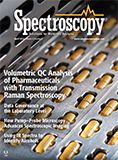Nanoparticles, SERS, and Biomedical Research
Duncan Graham of the University of Strathclyde is pushing the limits of what can be achieved using functionalized nanoparticles and SERS, in applications such as cholera detection, lipid profiling in cancer cells, and assessing the efficacy of anti-cancer drugs.
In biomedical applications of surface-enhanced Raman spectroscopy (SERS), nanoparticles can enhance the Raman signal and provide additional functionality. Duncan Graham of the University of Strathclyde has been pushing the limits of what can be achieved using functionalized nanoparticles and SERS, in applications such as cholera detection, lipid profiling in cancer cells, and assessing the efficacy of anti-cancer drugs.
You have been using a combination of nanoparticles and SERS in a variety of methods and applications related to biomedical use. What are the various functions that the nanoparticles play?
We use metallic nanoparticles of a variety of different compositions, shapes, and sizes for our research. The most fundamental properties of these nanoparticles is that they enhance Raman scattering and for that purpose, we prefer plasmonic nanoparticles such as silver or gold, although we are well aware of some of the newer nanoparticle materials based on semiconductors that are emerging in the SERS field as alternatives.
When we started in this field over 20 years ago, most of the surface chemistry for SERS had been developed to work with gold nanoparticles. My background, however, was in synthetic chemistry and I was interested in developing robust surface chemistries that worked well with silver nanoparticles, which typically give a larger enhancement of Raman scattering than gold nanoparticles. We have been able to build up a repertoire of ligands and chemistries for functionalization of predominantly silver nanoparticles. We also have started to understand more about the complex surface interactions going on for both gold and silver nanoparticles with a number of target analytes.
So getting to your question, the first function that the nanoparticle displays is enhancing the Raman scattering. The second function we are interested in is using them as a linker; because of their large surface area we can add multiple species to one nanoparticle and effectively view the nanoparticle as a linker between the species and a tag. For instance, a DNA sequence and a strongly scattering molecule such as malachite green isothiocyanate can be added to a nanoparticle in a self assembly process that effectively tags the DNA sequence with the malachite green through a nanoparticle, resulting in a strong SERS signal. The large surface area of the nanoparticle allows us to add multiple molecules per nanoparticle, which is interesting from a delivery perspective but also in terms of looking for cooperative binding effects when targeting weak noncovalent interactions such as antibody–antigen interactions or DNA hybridizations. The third function of the nanoparticles that we are interested in is that they have a plasmonic heating effect when we tune our excitation frequency to match the plasmon of the nanoparticles. We can experience significant heating and by playing with the nanoparticle composition, the molecular functionalization, and the excitation frequencies, we can tune between seeing enhancement of Raman scattering and heating up of the system. By controlling and investigating these three different functions we are able to use our nanoparticle-based approaches in a variety of different applications for biomedical use.
In one application, you have developed silver glyconanoparticles for low volume and rapid detection of cholera toxin B subunits in freshwater using SERS detection (1). Can you explain briefly how this works?
We are very interested in looking at interactions that can aggregate nanoparticles and as a consequence change the degree of enhancement of Raman scattering from molecules attached to the surface of these particles. In preliminary work we had shown how ConA [concanavalin A, a glucose-specific plant lectin] could interact with glucose-functionalized nanoparticles and we could follow this by SERS at very sensitive levels. That wasn’t particularly useful, however, so we started to look for other protein–sugar interactions that could still result in a change in nanoparticle aggregation and follow this using SERS.
The cholera toxin B subunit is a pentameric protein that is released by cholera and interacts with ganglioside GM1, which is located in your gut. This is the reason that cholera toxin ends up being nasty to the human system. There had been some previous studies looking at the cholera toxin B subunit interaction with sugar-coated nanoparticles that had only looked at the plasmonic color changes and had used reasonably complex sugar chemistry. The interaction between the ganglioside and the cholera toxin B subunit is quite complex, with a number of different points of contact from the ganglioside, which was always going to be a synthetic challenge. To shortcut this, we came up with two different linking units that made use of the key sugar residues in the ganglioside, namely galactose and sialic acid. By investigating the ratio of sialic acid to galactose on the nanoparticles and also the spacing away from the surface of each residue we were able to develop a functionalized nanoparticle that interacted very accurately with the cholera toxin B subunit, causing aggregation of the nanoparticles, which we could follow by SERS: In other words, as cholera toxin concentration increased we saw an increase in the SERS signal due to aggregation of these functionalized nanoparticles.
What advantages does this approach to detecting cholera offer compared to previous approaches?
At this stage we have just the proof of principle and we know that we can use a handheld portable Raman system that runs on batteries, meaning that the field portability of this system is very compelling. The cost of such a system is reasonable; however, we still have significant work to do before this becomes a field-deployable SERS detection system.
What challenges remain to make this approach practical for use with patient samples?
This approach was developed predominantly for testing of water samples in areas affected by cholera or potentially affected by cholera. For medical diagnostics, we are using a similar approach but not in solution, rather using a stationary phase and a capture approach, where we can look for either bacteria or micro RNA sequences indicative of disease. This work is still in its infancy but is showing significant promise in moving from a high-performance-instrument-based assay to a point-of-use assay for a specific diagnostic.
You are currently working on lipid profiling in cancer cells using nanoparticles and SERS for purposes such as assessing the effect of anti-cancer drugs. How does this approach work?
The lipid profiling work is pretty new for us and we are seeing some excellent results when comparing normal back scattered Raman mapping of cells with CARS [coherent anti-Stokes Raman spectroscopy] imaging and also we have started to look at anti-cancer drugs with nanoparticles. This work allows us to show cellular structure and molecular changes in an image based on the scattering intensity arising from the lipids and proteins. We are also starting to follow the drug attached to the nanoparticle using the enhanced Raman scattering of the drug. Drug concentrations are typically pretty low inside single cells, hence the use of nanoparticle to enhance the SERS signal, which allows us to follow the movement of the drug–nanoparticle conjugate as well as to produce three-dimensional images with point of reference to the higher concentration signals from the cellular cytoskeleton such as the lipid membranes and proteins.
What are the main challenges you have to overcome to make this approach work?
The main challenge here is to understand the specific lipids, which we see from broad signals and which can contain multiple species in the Raman scattering, and also how to accurately assess the change in IC50 [which is a measure of drug efficacy] as a result of the effect of drugs when they are attached to nanoparticles. This is not a trivial challenge and we need to understand more about drug efficacy when the drug is attached to the nanoparticles. The important thing as well is not just to look at the efficacy of the drug but to understand more about changes in molecular composition of the cell, which is where the Raman scattering comes in. Coupled with that we need to understand which specific molecules and which specific lipids are changing in terms of being either up- or down-regulated by synthetic pathways.
What have you been able to achieve so far?
We have several three-dimensional images where we can see our specific drug added to the nanoparticle inside a cancer cell and we can see where this is located. We have started to understand the change in lipid biosynthesis as a whole within cells when anticancer drugs have been added to them. It is incredibly complex but our collaborators in the cancer research fields are pretty excited about the amount of data and the challenge ahead of interpreting this in a meaningful fashion.
You have also been developing a type of nanoparticle to enhance SERS called “nanostars.” What are nanostars and how do they work?
Nanostars are three-dimensional particles that have prongs extended from the surface and give rise to very strong scattering of light from the surface. The nanostars can be produced in a number of different ways from either silver or gold and can be produced with tunable plasmon responses from the visible to the near infrared. Many other groups are working on using nanostars for SERS and other applications. Where I think we differ slightly is that we have been looking at the chemistry of the nanostar synthesis coupled with the SERS detection and subsequent properties in a bit more detail, which appears to be giving us some significant control over their stability and reproducibility as well as the degree of enhancement from the system that we are investigating.
Reference
- J. Simpson, D. Craig, K. Faulds, and D. Graham, Nanoscale Horiz.1, 60 (2016). DOI: 10.1039/c5nh00036j
This interview has been edited for length and clarity. To read the full interview please visit: http://www.spectroscopyonline.com/nanoparticles-sers-and-biomedical-research

Duncan Graham is the research professor of chemistry and head of department for pure and applied chemistry at the University of Strathclyde in Glasgow. He obtained his BSc Honours in Chemistry from the University of Edinburgh in 1992 and his PhD in bioorganic chemistry in 1996 He is a cofounder and director of Renishaw Diagnostics Ltd. (formerly D3 Technologies Ltd.), which formed in 2007.

AI-Powered SERS Spectroscopy Breakthrough Boosts Safety of Medicinal Food Products
April 16th 2025A new deep learning-enhanced spectroscopic platform—SERSome—developed by researchers in China and Finland, identifies medicinal and edible homologs (MEHs) with 98% accuracy. This innovation could revolutionize safety and quality control in the growing MEH market.
New Raman Spectroscopy Method Enhances Real-Time Monitoring Across Fermentation Processes
April 15th 2025Researchers at Delft University of Technology have developed a novel method using single compound spectra to enhance the transferability and accuracy of Raman spectroscopy models for real-time fermentation monitoring.